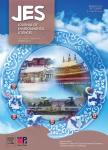Evolution in physiochemical and cloud condensation nuclei activation properties of crop residue burning particles during photochemical aging
Evolution in physiochemical and cloud condensation nuclei activation properties of crop residue burning particles during photochemical aging作者机构:Collaborative Innovation Center of Atmospheric Environment and Equipment Technology Nanjing University of Information Science and Technology Harvard-NUIST Joint Laboratory for Air Quality and Climate (JLAQC) Nanjing University of Information Science and Technology NUIST Reading Academy Nanjing University of Information Science and Technology
出 版 物:《Journal of Environmental Sciences》 (环境科学学报(英文版))
年 卷 期:2019年第31卷第3期
页 面:43-53页
核心收录:
学科分类:0830[工学-环境科学与工程(可授工学、理学、农学学位)] 07[理学] 070602[理学-大气物理学与大气环境] 0706[理学-大气科学]
基 金:supported by the National Key Research and Development Project(No.2016YFC0202402) the National Natural Science Foundation of China(Nos.41575122 and 41675126) the Priority Academic Program Development of Jiangsu Higher Education Institutions
主 题:Crop residue burning Aging Cloud condensation nuclei activity Hygroscopicity Organic aerosol
摘 要:As a main form of biomass burning in agricultural countries, crop residue burning is a significant source of atmospheric fine particles. In this study, the aging of particles emitted from the burning of four major crop residues in China was investigated in a smog *** particle size distribution, chemical composition and cloud condensation nuclei(CCN)activity were simultaneously measured. The properties of crop residue burning particles varied substantially among different fuel types. During aging, the particle size and mass concentration increased substantially, suggesting condensational growth by formation of secondary aerosols. The particle composition was dominated by organics. Aging resulted in considerable enhancement of organics and inorganics, with enhancement ratios of 1.24–1.44 and 1.33–1.76 respectively, as well as a continuous increase in the oxidation level of organics. Elevated CCN activity was observed during aging, with the hygroscopicity parameter κ varying from 0.16 to 0.34 for fresh particles and 0.19 to 0.40 for aged *** on the volume mixing rule, the hygroscopicity parameter of organic components(κorg) was derived. κorgexhibited an increasing tendency with aging, which was generally consistent with the tendency of the O:C ratio, indicating that the oxidation level was related to the hygroscopicity and CCN activity of organic aerosols from crop residue burning. Our results indicated that photochemical aging could significantly impact the CCN activation of crop burning aerosols, not only by the production of secondary aerosols, but also by enhancing the hygroscopicity of organic components, thereby contributing to the aerosol indirect climate forcing.



